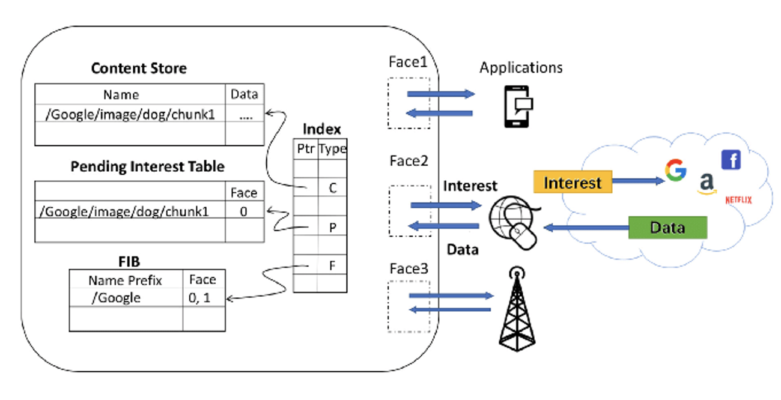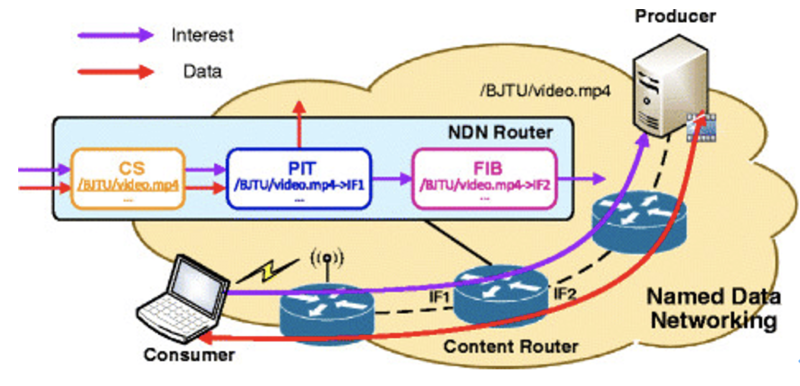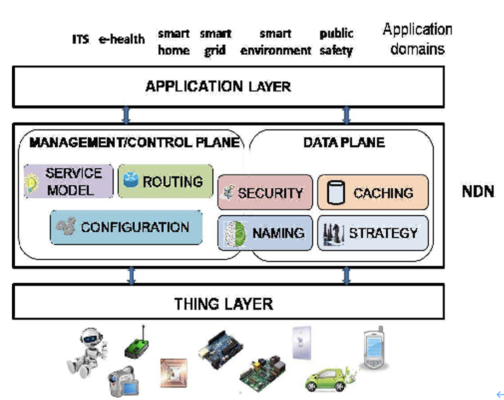1. What is Named Data Networking for IoT
The rise of the Internet of Things (IoT) has urged a new Internet architecture as IoT differs from the current Internet architecture due to constraints of devices’ resources and enormous volumes of small exchanged data. Therefore, scientists and engineers have come up with the Named Data Networking (NDN), content-centric networking that is more compatible with the requirements of IoT. The benefits of the current device-centric IP-based solutions are undeniable: IP is a well-defined standard that allows establishing communication between entities in different domains. However, on a larger scale as in IoT with billions of devices interconnected, IP-based solutions face multiple challenges. The use of IP addresses requires additional resolution systems for translating requests at the application level into IP addresses and also protocols to support mobility.

Source: https://www.google.com/imgres?imgurl=https%3A%2F%2Fwww.researchgate.net%2Fprofile%2FRodolfo-Coutinho%2Fpublication%2F327390170%2Ffigure%2Ffig1%2FAS%3A676645363003392%401538336234155%2FEntities-of-named-data-networking.png&imgrefurl=https%3A%2F%2Fwww.researchgate.net%2Ffigure%2FEntities-of-named-data-networking_fig1_327390170&tbnid=E0ul-CvZu6QnzM&vet=12ahUKEwiC–HHnYvyAhUPHKYKHZx9B-AQMygAegUIARCaAQ..i&docid=rEZ7yhxBXxGV3M&w=681&h=334&q=Named%20Data%20Networking&ved=2ahUKEwiC–HHnYvyAhUPHKYKHZx9B-AQMygAegUIARCaAQ
Meanwhile, the novel Named Data Networking gives a name to each content/data and utilizes this name to retrieve any information. Connected nodes in the network specify what they search for without the need for the expected location of interesting data. Any authorized user can request data by using a unique name of that self-authenticating and self-identifying object. In addition, each packet’s security in ensured by NDN at the time of its production and thus enable data caching at each node while maintaining the data’s security throughout the packet’s lifetime. These features make NDN a promising solution for the IoT ecosystem, where the same data may be requested by applications spanning multiple domains and billions of nodes communicate simultaneously.
2. Usage and Examples
 Source: https://www.researchgate.net/figure/The-sketch-map-of-Named-Data-Networking_fig4_308225799
Source: https://www.researchgate.net/figure/The-sketch-map-of-Named-Data-Networking_fig4_308225799
NDN defines a simple model for communication with the exchange of only two packets types, Interest and Data, which carry application-specific and ordered content/data names. NDN carries the data publisher’s signature and authentication information in each Data in order to secure authenticity and content integrity.
Each NDN node is constituted of three main components: a Content Store for temporary storing of incoming Data packets, a routing table called Forwarding Information Base (FIB) with the main purpose of guiding the Interests towards Data and a Pending Interest Table (PIT) that can be used to record the forwarded Interests that are not yet compatible with a returned Data packet. When an NDN node receives an Interest, it looks for a name prefix in its content store that is the longest match. If such a name is found, then the node sends the Data back to the original publisher of the Interest. If, however, there is already a matching PIT entry, the latest Interest will be discarded as a previous equal request has been already forwarded. If this new Interest is unique, a new PIT entry is generated, and in the worst case when a match is unable to be located in the PIT, then the data packet is dropped.
 Source: https://www.semanticscholar.org/paper/Named-data-networking-for-IoT%3A-An-architectural-Amadeo-Campolo/2e615142d4f447286d5a0a5352663a5076252d9f/figure/1
Source: https://www.semanticscholar.org/paper/Named-data-networking-for-IoT%3A-An-architectural-Amadeo-Campolo/2e615142d4f447286d5a0a5352663a5076252d9f/figure/1
The research and development of NDN for IoT is still at its early stage, however, multiple viable applications have been proposed and one of the most notable one is NDN-based smart home architecture. In a smart home, a variety of sensors and actuators are used for multiple purposes including energy management, security, and health care. Many smart-home applications involve only two simple main operations of retrieving data and sending commands to actuators. Despite the simple characteristics of these actions, communication over IP can still be complex because of the miscellaneous communication technologies and resource constraints. By implementing NDN architecture, users can retrieve data directly and instantly from a specific sensor, by sending an Interest packet for information. In addition, sensors can communicate with the home server and with the user simultaneously and the user can broadcast the same Interest packet and receive the data from the nearest source within the range, rather than carrying the IP address of the server and the packet while routing all over the house to reach the server.
3. Conclusion
Named Data Networking is emerging as one of the promising future architectures of the Internet in general and the Internet of Things ecosystem in particular. Besides its potential as a viable solution for interconnecting devices, its innovative concepts, such as named content, in-network caching, and also name-based routing will be developed and implemented to meet the IoT challenges in the coming years.
4. References
https://www.researchgate.net/publication/268195766_Named_data_networking_for_IoT_An_architectural_perspective
https://www.sciencedirect.com/science/article/pii/S2405959516301072
